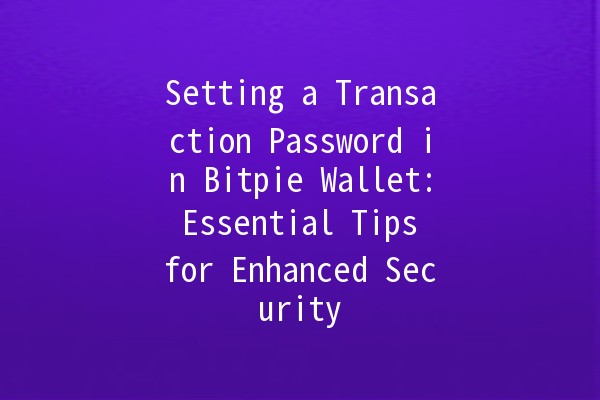
In today's digital landscape, safeguarding your cryptocurrency assets is of paramount importance. One of the most critical steps you can take to protect your funds is to set a transaction password in your Bitpie wallet. This article delves into the significance of a transaction password, provides practical tips for enhancing productivity while securing your assets, and addresses some frequently asked questions about the process.
The Importance of a Transaction Password
A transaction password is an additional layer of security that protects your digital assets from unauthorized access and transactions. Even if someone gains access to your wallet, they won't be able to execute transactions without this password. Here are a few compelling reasons to set a transaction password:
Enhanced Security: A transaction password significantly reduces the risk of unauthorized transactions, thereby safeguarding your investments.
User Control: It ensures that only you have the authority to approve transactions from your wallet.
Peace of Mind: Knowing that your assets are secure allows you to focus on trading and investing without worrying about potential threats.
Tips for Setting a Transaction Password

When creating your transaction password, consider the following tips to ensure it's effective:
Length and Complexity: Your password should be at least 12 characters long and include uppercase and lowercase letters, numbers, and special characters.
Avoid Predictable Patterns: Steer clear of easily guessable information such as birthdays or common words.
Example: Instead of “Password123,” use “G8^sA&jM1!qR!”
2FA adds an additional layer of protection by requiring a second form of verification when making transactions. To set this up in your Bitpie wallet:
Enable the 2FA feature within the wallet settings.
Link your wallet to an authenticator app like Google Authenticator or Authy.
Ensure you save backup codes provided during the setup process.
Example: When conducting a transaction, you will enter your password and then be prompted for a code from your 2FA app.
Changing your password periodically is crucial in maintaining security. Set reminders to update your transaction password every three to six months.
Example: After every major cryptocurrency market shift or personal circumstance change, consider changing your password.
Your wallet’s recovery keys are essential for accessing your funds in case you forget your transaction password. Here’s how to manage them securely:
Write Them Down: Store recovery keys in a physical location, such as a safe, where only you can access them.
Avoid Digital Storage: Refrain from saving them on your phone or computer to minimize the risk of hacking.
Example: Use a fireproof and waterproof safe to store your recovery keys securely.
Phishing scams are a prevalent threat where malicious actors attempt to gain access to your wallet by impersonating a legitimate service. Protect yourself by:
Checking URLs: Always verify that you are on the official Bitpie website before entering your credentials.
Avoiding Suspicious Links: Do not click on links in unsolicited emails or messages claiming to be from Bitpie.
Example: Bookmark the official Bitpie wallet page so you can directly access it without relying on search engines.
Frequently Asked Questions
If you forget your transaction password, try to reset it using the recovery options provided in the wallet. If that doesn’t work, use your recovery keys to regain access. For further assistance, reach out to Bitpie’s customer support.
It's strongly advised against reusing passwords across different platforms. Each password should be unique to minimize risks. Using different passwords for your wallet and transaction password will provide extra security for your digital assets.
To enable 2FA, go to the security settings within your Bitpie wallet. Follow the onscreen instructions to link your wallet to your preferred authenticator app. Ensure you save the backup codes in a secure location.
If your wallet is compromised, immediately change your transaction password and other account credentials. Transfer your assets to a new wallet using your recovery keys. Notify Bitpie support to take additional precautions.
Storing your transaction password digitally, especially in cloud services, increases the risk of hacking. Always opt to keep it in a physical format in a secure location to maximize security.
It's advisable to change your transaction password every three to six months or immediately after any significant security event or risk. Regular updates help maintain the integrity of your wallet security.
The digital world is fraught with potential risks, especially concerning cryptocurrency wallets. Taking proactive measures, such as setting a transaction password and implementing security best practices, can greatly enhance the safety of your assets. By following the tips provided, you can secure your digital investments and gain peace of mind as you navigate the evolving landscape of cryptocurrencies.

